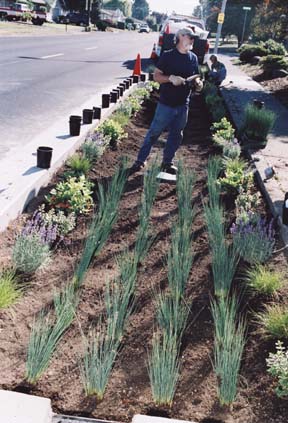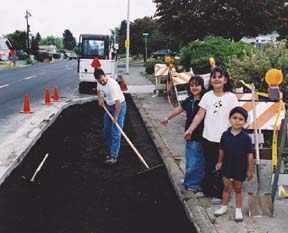 |
||||||||
| FEATURE ARTICLES | Memo Calendar | Memo Pad | Business Memos | Loaves & Fishes | Letters | Home | ||
 |
| Portland Parks & Recreation horticulturist Tom Henn, left, plants Mid-County’s first bioswale in the Argay neighborhood, while seasonal worker Josh Christopher helps. |
 |
| Kevin Perry, a landscape architect with the City of Portland Bureau of Environmental Services, prepares a mix of sand, soil and compost prior to adding plants that will filter pollutants from stormwater that is channeled into this curb extension swale at Northeast Fremont Street and 131st Place with the help of, from left, Rachel Anna, and Stevie Thompson. |
| MEMO PHOTOS: TIM CURRAN |
DARLENE VINSON
THE MID-COUNTY MEMO
Mid-Multnomah County is a watershed. Every drop of rain that falls in Mid-County eventually flows into either the Willamette or Columbia rivers. Historically, soil, trees and other vegetation absorbed rainwater and filtered it before it found its way back to rivers and streams. Establishment of homes, schools and businesses has reduced plant material and covered bare soil with impervious surfaces.
When it rains, tire dust and oils from roadway surfaces, fertilizers, pesticides and loose soil from yards and an assortment of pollutants from rooftops are carried into storm drains and into local waterways. This runoff causes flooding and soil erosion, can destroy wildlife habitat and contributes to combined sewer overflows.
Citizens of East Portland can reduce the impact their daily lives have on the environment. Currently, when developers disturb habitat to establish a housing community, or business property, they are required to design the project so that it mitigates disruption. That makes sense, and sounds pretty easy when mitigation is part of the design plan, but what about areas that are well established and there was no such mitigation requirement in place at the time of construction? The answer: plenty.
Individually, property owners can add trees to landscapes, select native or more ecologically responsible plantings, and reduce or eliminate the use of fertilizers and pesticides. Community wide efforts can present a bigger challenge, but as neighbors in Argay Terrace have learned, there are some great options available.
Last spring the Argay Neighborhood Association, the Bureau of Environmental Services and Portland Department of Transportation worked together to identify particular streets in Argay that could, according to Kevin Perry of BES, “use some additional attention to improve pedestrian safety and provide direct stormwater management benefit and demonstration value.” He goes on to say that, “the intersection of Northeast Fremont Street and 131st Place quickly became a top choice because there was a need to provide a better, safer pedestrian crossing at this location,” the site of a crosswalk for Shaver Elementary School.
As a result of this joint effort, a vegetated curb extension swale was designed to capture stormwater as it runs along the curb on Fremont. The project also includes ramps at the intersection that comply with the Americans with Disabilities Act.
Stormwater enters the swale at a cut at its east end and is channeled through a variety of plant material that works to slow the flow of the water and filter sediment and pollutants.
Perry says, “The stormwater facility will manage about 4,500 square feet of runoff from Northeast Fremont Street. If a storm event is particularly intense, water will continue to move through the curb extension and exit through a notch in the curb and continue down the street to the existing storm inlet.”
While it was important to create an efficient, functioning water treatment facility, aesthetics were equally important during the design phase. With that in mind, low growing, evergreen plants that exhibit drought tolerance and seasonal interest were included along with Grooved Rush, which Perry describes as the “workhorse of the system.” A native, wetland plant, Perry says, “Its stiff structure helps filter out debris and pollutants while its extensive roots promote the absorption of water.”
The Argay Neighborhood Association has actively sought ways to improve the livability of the neighborhood using ecologically responsible ideas. When the neighborhood was identified as “tree deficient” leaders worked with Friends of Trees to encourage residents to plant street trees early last spring. While dozens of trees were planted, the goal is to eventually add 900 trees to the neighborhood.
With the Argay neighborhood as part of the Columbia Slough Watershed, the association was eager to become part of the BES effort to manage stormwater locally. This demonstration project is one of only three-curb extension projects in the city and serves as an outstanding example of the value and leadership Mid-County neighborhood associations provide.
 |
 |
 |
MEMO Advertising | MEMO Archives | MEMO Web Neighbors | MEMO Staff | Home